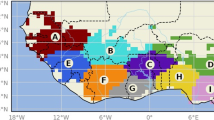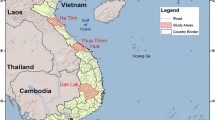Abstract
This paper considers the economic behaviour of smallholder farmers in eastern Ethiopia and its effects on their poverty status, looking specifically at how farmers deal with production risk and various time horizons. Earlier studies in rural Africa suggested that these are interlinked but that remains analytically unsatisfactory. Through experiments, we seek to disentangle risk preferences and time horizons regarding their impact on poverty. We find that the studied farmers are highly risk-averse and time-impatient; few farmers make longer-term investments. This appears to be covariant with wealth and household indicators, with poorer, less-educated farmers with smaller landholdings making less risky investments, thus yielding smaller returns, which shorten their time horizons. This finding is relevant for rural development policies, in particular suggesting how untying the Gordian knot of risk and time that reproduces rural poverty depends on the simultaneous operation of market and state forces.
Résumé
Cet article étudie le comportement économique des petits exploitants agricoles dans l’est de l’Éthiopie et ses effets sur leur situation de pauvreté, en examinant en particulier la manière dont les agriculteurs traitent les risques liés à la production et les divers horizons temporels. Des études antérieures menées en Afrique rurale ont suggéré que ceux-ci (le risque et le temps) sont liés entre eux mais cela reste insatisfaisant d’un point de vue analytique. À travers une approche expérimentale, nous cherchons à démêler l’impact qu’ont les préférences de risque et les horizons temporels sur la pauvreté. Nous trouvons que les agriculteurs qui font partie de l’étude ont une aversion au risque et sont impatients; peu d’agriculteurs font des investissements à plus long terme. Cela semble être corrélé aux indicateurs de richesse et ménage: les agriculteurs les plus pauvres et ayant un niveau d’études moindre, dotés de propriétés foncières plus petites, effectuent des investissements moins risqués, produisant ainsi des rendements plus faibles, ce qui raccourcit leur horizon temporel. Cette constatation est pertinente pour les politiques de développement rural, suggérant notamment que dénouer le nœud gordien risque-temps, qui engendre la pauvreté en milieu rural, dépend du fonctionnement simultané des forces du marché et des forces de l’État.
Similar content being viewed by others
Notes
Risk is an ordinal variable, but both time preference and household income are continuous variables (see Appendix C for a definition of variables included in the study). An endogeneity problem in our model would result mainly from simultaneity bias (reverse causation).
The kebele is the smallest administrative unit in Ethiopia.
One US Dollar equalled about 18.70 Ethiopian Birr at the time of the survey.
There were no inconsistent respondents in our study, meaning that RTPs could be estimated for all respondents. Such absence of inconsistent respondents is important to check for a bias emanating from missing samples, because missing samples would effectively reduce the sample size and the sampling error would thereby be increased.
References
Alem, Y., M. Bezabih, M. Kassie, and P. Zikhali. 2010. Does fertilizer use respond to rainfall variability? Panel data evidence from Ethiopia. Agricultural Economics 41 (2): 165–175.
Anderson, C., D. Maya, G. Andrew, and K. Marieka. 2004. Discount rates in Vietnam. Economic Development and Cultural Change 52 (4): 873–887.
Becker, G.S., and C.B. Mulligan. 1997. The endogenous determination of time preference. Quarterly Journal of Economics 112 (3): 729–758.
Binswanger, H.P. 1980. Attitudes toward risk: Experimental measurement in rural India. American Journal of Agricultural Economics 62: 395–407.
Brock, P.L. 1996. Toward environmentally sustainable development in Sub-Saharan Africa: A World Bank agenda. Washington, DC: World Bank.
Chavas, J. 2004. Risk analysis in theory and practice. London: Elsevier.
Dynan, K.P., S. Jonathan, and Z. Stephen. 2004. Do the rich save more? Journal of Political Economy 112 (2): 397–444.
Fafchamps, M. 2010. Vulnerability, risk management and agricultural development. African Journal of Agricultural and Resource Economics 5 (1): 243–260.
Fisher, I. 1930. The theory of interest. New York: Macmillan.
Greene, W.H. 2012. Econometric analysis, 7th ed. Prentice Hall, NJ: Upper Saddle River.
Hagos, F. 2003. Poverty, institutions, peasant behaviour and conservation investment in Northern Ethiopia. PhD Dissertation, Agricultural University of Norway, Aas, Norway.
Holden, S., S. Bekele, and W. Mette. 1998. Poverty, market imperfections, and time preferences: Of relevance for environmental policy?. Environment and Development Economics 3: 105–130.
Liebenehm, S., and H. Waibel. 2014. Simultaneous estimation of risk and time preferences among small-scale cattle farmers in West Africa. American Journal of Agricultural Economics 96 (5): 1420–1438.
Lipton, M. 1968. The theory of the optimising peasant. Journal of Development Studies 4 (3): 327–351.
Liu, Elaine M. 2008. Time to change what to sow: Risk preferences and technology adoption decisions of cotton farmers in China. Working Paper No. 1064, Princeton University.
Markandya, A. and D. Pearce. 1988. Environmental considerations and the choice of the discount rate in developing countries. Environment Department Working Paper No.3. Washington, DC: World Bank.
Nguyen, Q. 2011. Does nurture matter: Theory and experimental investigation on the effect of working environment on risk and time preferences. Journal of Risk and Uncertainty 43 (3): 245–270.
Olson, M., and M.J. Bailey. 1981. Positive time preference. Journal of Political Economy 89 (1): 1–25.
Pender, J. 1996. Discount rates and credit markets: Theory and evidence from rural India. Journal of Development Economics 50: 257–296.
Pennings, J.M., and P. Garcia. 2005. The poverty challenge: How individual decision-making behavior influences poverty. Economics Letters 88 (1): 115–119.
Stiglitiz, J., and A. Weiss. 1981. Credit rationing in markets with imperfect information. The American Economic Review 71 (3): 393–410.
Tanaka, T., C.F. Camerer, and Q. Nguyen. 2010. Risk and time preferences: Linking experimental and household survey data from Vietnam. American Economic Review 100 (1): 557–571.
Wik, M., A. Tewodros, B. Olvar, and Stein T. Holden. 2004. On the measurement of risk aversion from experimental data. Applied Economics 36 (21): 2443–2451.
Yesuf, M., and R. Bluffstone. 2008. Wealth and time preference in rural Ethiopia. Discussion Paper Series: Environment for Development.
Yesuf, M., and R. Bluffstone. 2009. Poverty, risk aversion and path dependence in low-income countries: Experimental evidence from Ethiopia. American Journal of Agricultural Economics 91 (4): 1022–1037.
Yesuf, M., and H. Teklewold. 2011. Risk preferences and technology adoption: Case studies from Ethiopian highlands. In Agricultural investment and productivity: Building sustainability in East Africa, ed. G. Köhlin and R. Bluffstone, 67–78. Abingdon, Oxon: RFF Press.
Acknowledgements
The authors would like to thank two anonymous reviewers as well as the editor for their comments. Financial assistance from NUFFIC (NICHE/ETH/019) project is well acknowledged. On behalf of all authors, the corresponding author states that there is no conflict of interest.
Author information
Authors and Affiliations
Corresponding author
Appendices
Appendices
Appendix A: The Basic Structure of Risk Experiments
Experimental sets | Bad harvest | Good harvest | Expected gain | Spread | CPRA coefficients (η) | Risk-aversion classification |
|---|---|---|---|---|---|---|
1 | 20 | 20 | 20 | 0 | > 7.47 | Extreme |
2 | 18 | 36 | 27 | 9 | 7.47 to 2.00 | Severe |
3 | 16 | 48 | 32 | 16 | 2.00 to 0.85 | Intermediate |
4 | 12 | 60 | 36 | 24 | 0.85 to 0.32 | Moderate |
5 | 4 | 76 | 40 | 36 | 0.32 to 0 | Slight to neutral |
6 | 0 | 80 | 40 | 40 | < 0 | Neutral to risk-seeking |
Appendix B: Time Preference Experimental Choice Sets
Set two: Timeframe = 6 months, reference date July 2013, and nominal magnitude = 100
Options | Choice |
|---|---|
100 Birr today or 128 Birr after 6 months | |
100 Birr today or 159 Birr after 6 months | |
100 Birr today or 192 Birr after 6 months | |
100 Birr today or 228 Birr after 6 months | |
100 Birr today or 265 Birr after 6 months |
Set three: Timeframe = 6 months, reference date July 2013, and nominal magnitude = 250.
Options | Choice |
|---|---|
250 Birr today or 276 Birr after 6 months | |
250 Birr today or 305 Birr after 6 months | |
250 Birr today or 351 Birr after 6 months | |
250 Birr today or 385 Birr after 6 months | |
250 Birr today or 463 Birr after 6 months | |
250 Birr today or 530 Birr after 6 months | |
250 Birr today or 686 Birr after 6 months |
Set four: Timeframe = 12 months, reference date July 2013, and nominal magnitude = 250.
Options | Choice |
|---|---|
250 Birr today or 276 Birr after 12 months | |
250 Birr today or 305 Birr after 12 months | |
250 Birr today or 351 Birr after 12 months | |
250 Birr today or 385 Birr after 12 months | |
250 Birr today or 463 Birr after 12 months | |
250 Birr today or 530 Birr after 12 months | |
250 Birr today or 686 Birr after 12 months |
Appendix C: Definitions of Variables Included in the Model
Variables | Description |
|---|---|
Age | Age of a household head measured in years |
Sex (female = 0) | Sex of a household head, which takes the value 1 if the head is man; 0 otherwise |
Education | Formal education level of a household head in years of schooling |
Membership | Whether a household head is member of a vegetable producer cooperative union or not |
Extension visit | If a household head has extension services access |
Frequency of shock | How frequently shocks occurred previously |
Land security | If a household feels secure about his land or not |
Value of domestic animals | The sum of values of domestic animals raised by a household |
Saving | The amount of money a household puts in formal financial institutions |
Number of plots | Number |
Access to credit | Whether a household has access to formal credit institutions (banks) |
Cash liquidity | The difference between household income and expenditure |
Access to non-farm income | If a household head participates in non-farm activities |
On-farm diversification | A binary variable showing whether the head participates in crop and activity diversification on the farm |
Family labour | Number of family hands applied to farm work |
Hired labour | Number of hired hands applied to farm work |
Credit received | The amount of money received by a household from creditors |
Farm implements | The monetary value of farm implements used by a household |
Irrigated land | Hectares |
Fertiliser use | Whether chemical fertiliser is used |
Manure use | Whether manure is used |
Soil fertility level | The soil fertility status of farm land as described by a household |
Access to information | Owning a a radio, tape recorder, television, or a combination |
Pesticide use | Whether pesticides are used |
Lag previous success | The lag of previous game success or failure |
Previous success | The outcome of a previous game, whether a household wins or loses |
Expected payoff | The expected amount in payoffs offered for players in each game |
Risk preference | The risk-aversion measure of a household |
Household income | The total income earned by a household from different activities |
Time preference | The discount rates computed from the time preference experiments |
Rights and permissions
About this article
Cite this article
Alemayehu, M., Beuving, J. & Ruben, R. Disentangling Poor Smallholder Farmers’ Risk Preferences and Time Horizons: Evidence from a Field Experiment in Ethiopia. Eur J Dev Res 31, 558–580 (2019). https://doi.org/10.1057/s41287-018-0168-x
Published:
Issue Date:
DOI: https://doi.org/10.1057/s41287-018-0168-x




